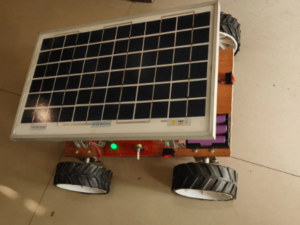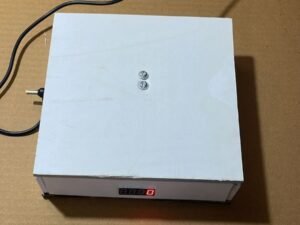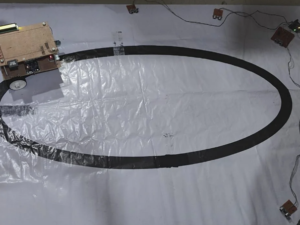Supervisory Control and Data Acquisition (SCADA) for Remote Industry
1 in stock
Supervisory Control and Data Acquisition (SCADA) systems are essential tools for industrial automation, enabling remote monitoring, control, and management of industrial processes. The Supervisory Controlling Plus Data Acquisition for Remote Industry project focuses on integrating SCADA systems with real-time data acquisition to improve operational efficiency, safety, and reliability in remote industrial environments.
₹11,800.00 ₹14,160.00 (Incl. GST)
1 in stock
Supervisory Control and Data Acquisition (SCADA) for Remote Industry
Supervisory Control and Data Acquisition (SCADA) systems are essential tools for industrial automation, enabling remote monitoring, control, and management of industrial processes. The Supervisory Controlling Plus Data Acquisition for Remote Industry project focuses on integrating SCADA systems with real-time data acquisition to improve operational efficiency, safety, and reliability in remote industrial environments.
Project Overview
The objective of this project is to design a system that can monitor and control industrial processes in remote locations, where direct human intervention might be difficult or impractical. By leveraging SCADA systems, the project ensures that industries like mining, oil and gas, power generation, and water treatment can function efficiently and safely, even from afar.
Key Components
- SCADA Software: The core of the system that enables visualization, monitoring, and control of industrial processes. SCADA software provides a central interface where operators can oversee and manage all connected devices.
- Data Acquisition Devices: These devices gather real-time data from industrial machinery and sensors. Examples include temperature sensors, pressure transducers, flow meters, and voltage/current monitors.
- Remote Terminal Units (RTUs): These are hardware devices that collect data from sensors, process it, and transmit it to the SCADA system for monitoring and control. RTUs often include communication modules for data transmission over networks.
- Programmable Logic Controllers (PLCs): PLCs control the equipment based on commands received from the SCADA system. These controllers are responsible for the automation of industrial processes such as pumps, motors, and valves.
- Communication Infrastructure: This includes wired or wireless networks, such as Ethernet, Wi-Fi, or cellular networks, which ensure reliable data transmission between the remote devices, RTUs, and SCADA system.
- Cloud Integration: For remote monitoring, data storage, and analytics, cloud platforms can be used to store data from the SCADA system, offering easier access and real-time analysis.
- Human-Machine Interface (HMI): The HMI is the visual interface that allows operators to interact with the system, observe real-time data, and make decisions. It provides graphical representations of the industrial processes.
- Security Systems: Protecting the system from unauthorized access is critical. This includes encryption protocols, firewalls, and user authentication to ensure the safety of both the data and the equipment being controlled.
Working Principle
- Data Collection: Sensors and devices at remote industrial sites continuously collect real-time data on environmental conditions, equipment performance, and process variables (e.g., temperature, pressure, flow rates).
- Data Transmission: The gathered data is transmitted to remote terminal units (RTUs) or directly to a central system via wireless or wired networks, ensuring that operators can access up-to-date information at any time.
- Data Processing and Visualization: SCADA software processes and displays the data on the human-machine interface (HMI). The system presents real-time graphs, gauges, and alarm notifications, enabling operators to monitor operational parameters efficiently.
- Control Commands: Based on the data and operator input, the SCADA system can issue control commands to connected devices (e.g., PLCs or RTUs), which in turn control machinery such as pumps, motors, or valves. These commands allow for remote operation and adjustment of industrial processes.
- Alerts and Alarms: When sensor readings exceed preset thresholds, the system sends automated alerts to operators, ensuring timely intervention before issues escalate.
- Cloud Analytics and Remote Monitoring: Integration with cloud systems allows operators to monitor data from anywhere in the world, providing flexibility in the decision-making process and improving efficiency.
Applications
- Oil and Gas Industry: SCADA systems monitor pipeline pressure, flow rates, and equipment conditions to ensure that oil and gas production and transportation operations run smoothly.
- Water and Wastewater Treatment: SCADA allows for remote monitoring of water quality, chemical dosing, and pump performance, optimizing water treatment processes and ensuring safe water supply.
- Power Generation and Distribution: SCADA helps in monitoring electrical grids, substations, and power plants. Operators can remotely control generators and transformers to ensure consistent power supply and avoid failures.
- Mining: In mining operations, SCADA can be used to monitor machinery, ventilation, and safety systems, ensuring safe and efficient mining operations, even in remote areas.
- Agriculture: SCADA systems can automate irrigation, monitor environmental conditions, and provide data-driven insights into crop growth and resource use.
Advantages
- Remote Monitoring and Control: Enables operators to oversee and control industrial processes from anywhere, reducing the need for on-site presence.
- Increased Efficiency: Automation of processes ensures continuous operations, reducing downtime, and enhancing productivity.
- Real-Time Data: SCADA systems provide real-time data, allowing operators to make informed decisions, address issues proactively, and optimize performance.
- Improved Safety: Early detection of problems (e.g., equipment malfunctions, dangerous gas levels) through data monitoring helps prevent accidents and enhances worker safety.
- Cost-Effective: Remote monitoring and automation reduce the need for manual labor and on-site inspections, saving both time and money.
- Predictive Maintenance: By analyzing historical and real-time data, SCADA systems can predict equipment failures before they happen, reducing unexpected downtime and maintenance costs.
Challenges
- Security Risks: The remote nature of SCADA systems introduces vulnerabilities in cybersecurity. Hackers could potentially gain control of critical systems or access sensitive data.
- Network Reliability: In remote locations, network connectivity issues can disrupt data transmission and delay real-time monitoring.
- Integration with Legacy Systems: Older industrial equipment may not support modern SCADA systems, requiring custom integration solutions.
- Data Overload: With constant data generation, it’s essential to ensure that the system efficiently handles and processes large amounts of data without slowdowns.
Conclusion
The Supervisory Control and Data Acquisition (SCADA) for Remote Industry project provides a critical solution for industries that operate in remote or hard-to-reach locations. By leveraging advanced technologies like IoT, cloud computing, and real-time data analytics, SCADA systems enable industries to monitor and control their processes remotely. This not only improves operational efficiency but also enhances safety and minimizes operational costs. The integration of secure, reliable communication networks and predictive maintenance further solidifies SCADA systems as the backbone of modern industrial automation in remote environments.





